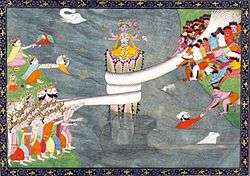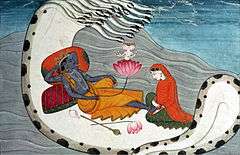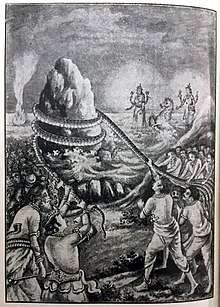Kshira Sagara
In Hindu cosmology, the Ocean of Milk is the fifth from the center of the seven oceans. It surrounds the continent known as Krauncha.[1] According to Hindu scriptures , the devas and asuras worked together for a millennium to churn the ocean and release Amrita the nectar of immortal life.[2] It is spoken of in the Samudra manthana chapter of the Puranas, a body of ancient Hindu legends. It is called as Thirupaarkadal in Tamil and is the place where Vishnu reclines over Shesha Naga along with his consort Lakshmi.[3]


Etymology
"Ocean of Milk" is the English translation of the Sanskrit terms kṣīroda, kṣīrābdhi or kṣīrasāgara, from kṣīra "milk" and -uda, sāgara "water, ocean" or abdhi "ocean."
The term varies across Indic languages, including khir sagar in Bengali, pārkaḍal in Tamil, and Pāla Kadali in Telugu.
The Churning of the Ocean

Hindu history also contains a story about the churning of the Cosmic Ocean in order to obtain Amrita – the nectar of immortal life. At the suggestion of Vishnu the (devas) and (asuras) churn the primeval ocean in order to obtain Amrita which will guarantee them immortality. To churn the ocean they used the Serpent, Vasuki, for their churning-string. For a churning pole they used Mount Mandara placed on the back of a Great Tortoise – the Kurma Avatar of Vishnu. As the gods and demons churned the sea, the terrible poison Halahala issued from its depths and began to envelop the universe with its choking fumes. Gasping for breath, the devas and asuras sought the help of Shiva, who valiantly took the poison into his throat and swallowed it. Shocked by his heroic act, the Goddess Parvati grasped him by the throat, trapping the poison there and preventing it from spreading; but, such was the strength of the poison, that it turned his neck blue, thereby earning him the name of Neelakanta (blue-throated one).[4] When the Amrita finally emerged along with several other treasures the devas and asuras fought over it. However Vishnu in the form of the enchantress Mohini managed to lure the asuras into handing over to "her" the Amrita, which she then distributes to the devas. Svarbhanu, an asura, disguises himself as a deva and tries to drink some Amrita himself. Surya (the sun-god) and Chandra (the moon-god) alert Vishnu to this deception. Vishnu then decapitates Svarbhanu just as he is about to swallow the nectar, leaving his head and decapitated body immortal.Later the head part is known as Rahu and the beheaded part is known as Ketu.
According to the Bhagavata, the products of the churning of Kshirasagara are the substances Halahala (the terrible poison neutralised by Shiva) and Amrita (the divine nectar); the divinities Dhanvantari (the physician of the Gods), Lakshmi (Goddess of Riches), Jyestha (Goddess of Poverty) and Chandra (the Moon); the animals Airavata, the white elephant and the horse Uchchaisrava and, last but not least, the magical wish-granting tree Kalpavriksha.
The Churning of the Cosmic Ocean (the Milky Way) is told in several ancient texts, notably in the Valmiki's Ramayana Canto 45 [5] and in the Mahabharata.[6]
Depiction at Angkor Wat
A bas-relief at the temple of Angkor Wat in Cambodia includes a depiction of devas and asuras working together to stir up the Ocean of Milk in an attempt to free the precious objects lost within, including the elixir of immortality called amrita. The scheme, masterminded by Vishnu, was to wrap the serpent Vasuki around Mount Mandara and then to rotate the mountain and to churn the surrounding sea in the manner of a gigantic food processor, by alternately pulling on the serpent's head and then on his tail.[7]
Svetadvipa
- There is a Vaikunthaloka covered with water in the material world, which is an inestimable distance away in the direction of the Makara Rashi (Shravana Zodiac) or the Capricorn Constellation, and on that planet, is a place called Vedavati, where Vishnu resides.
- Another planetary system known as Vishnuloka, also an inestimable distance away and again in the direction of the Makara Rashi (Shravana Zodiac) or the Capricorn Constellation, is situated above Satyaloka (see: Vaikuntha) and that is where Sankarshana is present.
- On the island known as Svetadvipa there is an Ocean of Milk, and in the midst of that ocean, is a place called Airavati-pura where Aniruddha lies on Ananta.
Cosmologically the Dvipas and Sagaras depict the entire Cosmos, though in Cartiography (or Cosmography), all the Dvipas and Sagaras are shown to lie in the Southern Hemisphere. In some of the satvata-tantras there is a description of the nine varshas and the predominating Deity worshiped in each:
Paramatma, the Supersoul in the heart of everyone through whom all Avatars come to material universe, is lying on that Milk Ocean. So Paramatma is Ksirodakasayi Vishnu – who is in every atom and heart of all 8 400 000 kinds of material bodies, as the soul in each heart called atma which in essence is same as the Paramatma).
References
- D. Dennis Hudson: The body of God: an emperor's palace for Krishna in eighth-century Kanchipuram, Oxford University Press US, 2008, ISBN 978-0-19-536922-9, pp.164-168
- "Churning the Ocean of Milk by Michael Buckley".
- Chenni Padmanabhan. Concept of Sri Andal's Tiruppavai. R.P. Publications, 1995 - Krishna (Hindu deity) in literature - 296 pages. p. 87.
- Flood, Gavin (1996). An Introduction to Hinduism. Cambridge: Cambridge University Press. ISBN 0-521-43878-0., pp. 78.
- "Online version of the Ramayana Canto 45 in English".
- "Online version of the Mahabharata in English".
- "Churning of the Ocean of Milk Travel Guide, Angkor Wat". AsiaExplorers.
External links
- The story of the churning as told in the epic Mahabharata, here in the online English translation by Kisari Mohan Ganguli at sacred-texts.com.
- The story of the churning as told in the epic Ramayana, here in the online English verse translation by Ralph T. H. Griffith at sacred-texts.com.
- The story of the churning as told in the Vishnu Purana, here in the online English translation by Horace Hayman Wilson at sacred-texts.com.
